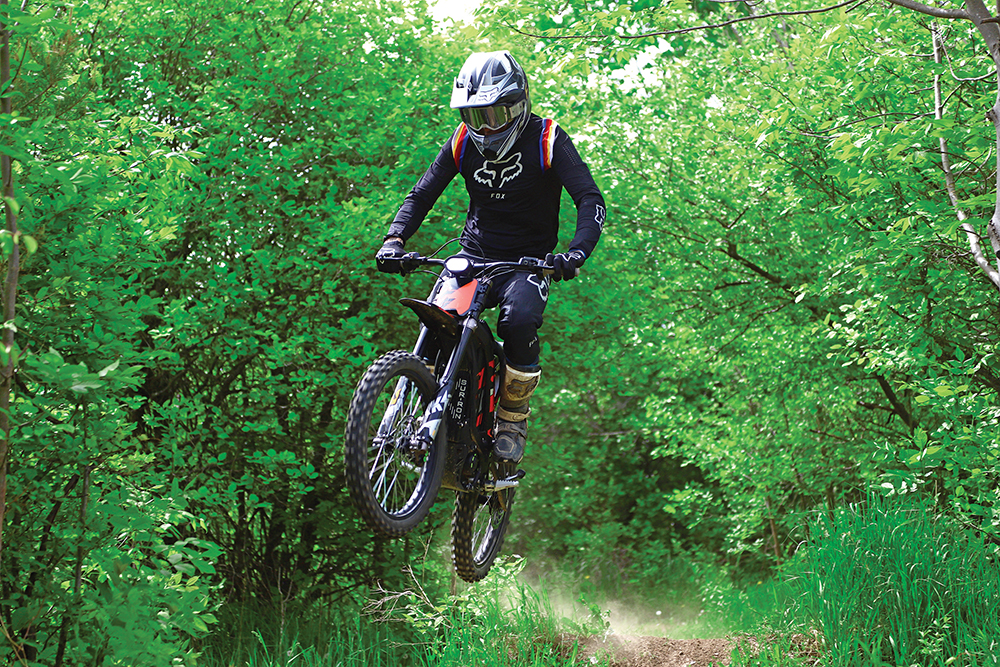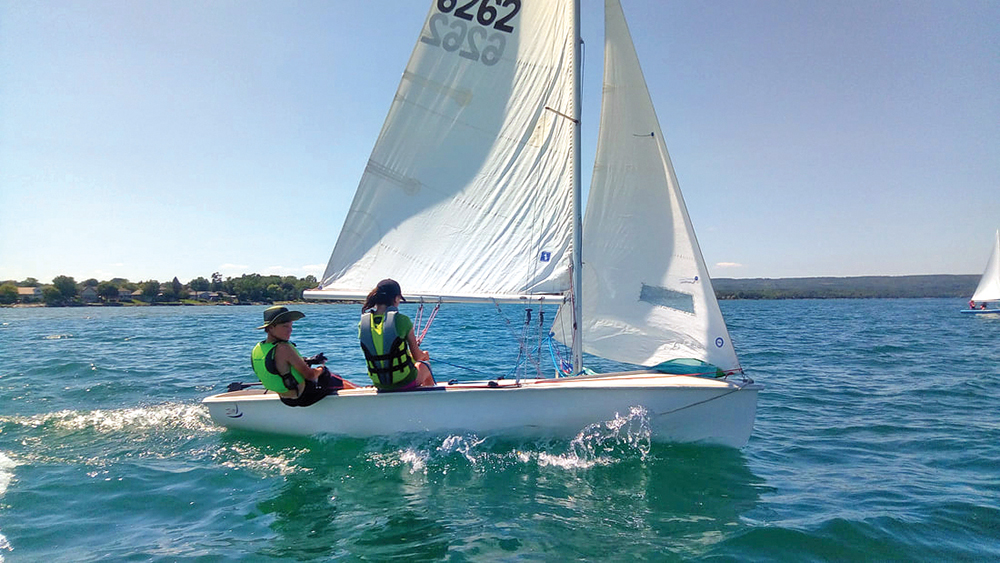Escarpment – Electric Dirt Bike – BMR Audit – Sailing school
by Dean Hollin

Big Forest vs Big Sprawl
Long-established conservation groups are uniting to protect the Niagara Escarpment’s widely celebrated landscapes, globally unique natural features and forests.
A newly formed conservation organization, the Escarpment Corridor Alliance (ECA), has partnered with like-minded organizations such as the Blue Mountain Watershed Trust, Escarpment Biosphere Conservancy, Friends of Silver Creek and Protecting Talisman Lands Association around the common cause of defending the Escarpment.
The new partnership seeks to preserve existing green spaces and shine a spotlight on the threats to the Niagara Escarpment around Southern Georgian Bay. ECA President Bruce Harbinson says citizen and conservation groups fighting battles to curb urban sprawl into sensitive areas can now be part of something bigger.
“We need to be in this together. We think we can bring greater attention and leverage by focusing on all of these micro-battles.”
One of those battles is a proposed development for 1,600 homes in a now-forested area at Castle Glen in the Town of The Blue Mountains. The former Talisman Resort in Grey Highlands is another significant Escarpment property where development has been opposed by local citizens and conservation groups.
Both the Castle Glen and Talisman properties fall inside existing “blue zones” on maps of the Niagara Escarpment Plan (NEP), Canada’s first environmental land-use plan, implemented in 1985. The zones are designated recreation areas in the NEP similar to existing ski resorts in the region. There are also existing class environmental assessments (EAs) for both proposed developments that outline plans for providing municipal sewer and water services to the development lands.
Harbinson admits that it’s an uphill battle but right now the stakes have never been higher, especially when it comes to Castle Glen.
“It’s 1,500 acres that’s slated for 1,600 homes. That’s a city of about 5,000 people. In the 49 years since the Niagara Escarpment Commission was formed, there has never been a development like this on the Escarpment, and we don’t think there should ever be a development like this on the Escarpment.”

The Dirt Bike Gets Clean
Nothing pierces the sound of silence like the ascending snorts of a motorcycle hitting the power band. High performance motocross demands everything that an engine can deliver to accelerate riders to the event-horizon of competition.
Grinding through mud and rough terrain requires torque and gearing, but control up in the air is just as essential. Weight considerations test the limits of materials and manufacturing. But when it comes to ultimate performance, everything is a give and take.
Dan Tricco has a deep-rooted appreciation for that equation. Tricco has been ripping up moto parks for three decades. He’s won three national championships in his age class and earned a reputation for pushing the limits on and off the track.
Over the past year he’s been testing something new for Parkway Yamaha, the local dealer of a purely electric motorcycle called the Sur Ron Light Bee X.
“You turn the key on and twist the throttle,” says Tricco. “There’s a couple of settings—sports mode, which is full power, which experienced riders use, and eco mode if you are a beginner.”
The off-road Light Bee X combines the aggressive nature of a dirt bike with the agility of a downhill mountain bike. It has a lightweight forged aluminum frame, a 60-volt Panasonic lithium ion battery, disc brakes and a total weight of just 50 kilograms.
This combination offers the rider a 100-kilometre range and enough torque to climb hills at 45 degrees. The amazing part, this clean machine is almost silent apart from the sound of the chain whirring over the sprockets. Tricco says the quiet nature of the bike opens up off-road riding to a broader spectrum of people. “In the past three months I’ve had 100 people ride this from big, burly Harley biker dudes to petite girls and everybody just giggles when they come back. It’s the coolest thing.”
A heads-up to mountain bikers: the front brake is on the right handlebar in a conventional motocross configuration. The Light Bee X retails for about $6,000.

Blue Mountain’s Sustainability Deep-Dive
When Jozo Weider first imagined a ski resort on the Escarpment slopes more than 80 years ago, winters were colder and longer than they are today. According to the Canada’s Changing Climate Report published in 2019, the mean annual temperature in Canada has already risen about 1.7 degrees Celsius since 1948.
Temperatures have increased more in northern Canada than in southern Canada, and more in winter than in summer. The farther north you go, the more dramatic the change has been. The report goes on to attribute more than half of the warming to “human-caused emissions of greenhouse gases.”
So far, ski areas with sufficient resources have been able to adapt. Snowmaking and grooming technologies have overcome the incremental shift in weather patterns and even improved conditions on the slopes—but there’s a catch. How sustainable is this technology-versus-nature approach over the long term? It requires significant amounts of energy and water to keep the slopes snow-covered in winter.
It’s this fundamental question that Blue Mountain Resort (BMR) is tackling head-on with a facility-wide audit of its operations.
“Being good stewards of the environment is not only something our team is passionate about, it is something we need to take action on to ensure the viability of what we do at Blue,” says Tara Lovell, BMR’s manager of public relations.
Three separate engineering firms started their independent analysis
earlier this year as part of the audit, reviewing current and historical data and internal reports, and comprehensively inspecting buildings and mechanical systems on and off the slopes. Considering the size of the resort, there is much to review.
Blue Mountain is Ontario’s largest mountain resort, with more than 1,000 accommodation units and 45 restaurants, bars and retail stores in the Village.
During summer months, the list of attractions include the Monterra Golf course, Ridge Runner Mountain Coaster, Cascade Putting Course, a ropes course and zip lines. In the winter, the resort is Ontario’s largest ski destination, operating 43 ski and snowboard trails and hosting 1.5 million visitors annually.
The audit will measure the baseline energy usage and paint a clear picture of the entire resort’s environmental impact. The data will also help create a plan to improve operational efficiency and reduce the resort’s net carbon footprint and greenhouse gas emissions.
“To make sure we are approaching our sustainability goals effectively, an up-to-date point of measurement needs to be established. As an Alterra Resort, we are participating in a sustainability audit. This will help us look critically at where we are at and where we need to go to make sure our environmental impact and our business viability continue in a positive direction,” says Lovell. Before the audit began, BMR was already making great strides in energy efficiency with the use of three-dimensional, GPS-guided snow mapping, snowmaking automation and the conversion to LED lighting on the slopes.
For more than 20 years, BMR has also been a member of the National Ski Areas Association (NSAA) Sustainable Slopes program which goes far beyond climate initiatives in its pledge to sustainability. The program includes waste reduction, design and construction guidelines so that new structures are harmonious with the landscape, as well as forest health and habitat stewardship. All of these focus areas overlap with BMR’s own environmental initiatives, which are published online.
The sustainability audit will go even further to ensure the resort is accountable, according to Lovell. “The resort has been submitting emissions data to the NSAA since 2000, but the nature of climate change has evolved and this audit will help us set meaningful benchmarks.”
The deep dive into sustainability comes as BMR’s parent company, Alterra, plans and budgets for the future. Alterra is one of four North American resort companies including Vail, POWDR and Boyne Resorts, that have all agreed to operate with sustainability at the forefront.
The audit at BMR has already produced a number of recommendations for improvements, including upgrades to the snowmaking and chairlift systems, lighting retrofits, programmable thermostats in buildings and improvements to kitchen ventilation systems. Some of the work will begin this year.
In addition, the resort has created a new full-time position within its ranks for a Sustainability Analyst. The analyst will work collaboratively with the operations and planning teams to oversee how growth and development align, while implementing the audit recommendations. The analyst will also monitor the resort and report on efficacy on an ongoing basis to help achieve the goal of resort-wide sustainability.

Learning the Ropes
Georgian Bay is a formable body of water that offers fun, excitement and adventure to those who have the skills to explore it. Whether your goal is to cruise the world’s largest freshwater archipelago in a yacht or to hike out over the side of a dinghy on steep wave faces, a good place to begin is the Meaford Harbour at Sail Georgian Bay, a unique school for the nautically inclined. Within the confines of Meaford’s seawalls, youngsters eight to 18 years old can learn to read the language of wind and water from experienced and qualified CANSail coaches.
Sail Georgian Bay has a fleet of small sailboats including more than a dozen beginner-friendly Laser Picos, plus five 420 dinghies—the world’s top youth racing sailboat, used by university sailing teams and in national youth championships.
The CANSail programming focuses on time on the water in a safe, active learning environment as well as some time in the classroom. Sailors learn the skills they need to have fun and challenging experiences suited to their age and stage of development, right up to CANSail 6, the top level of Sail Canada’s dinghy training standards.
For many, on-water fun is a path to summer employment. Most of the school’s instructors came up through the school as students.
Sail Georgian Bay is a volunteer-based organization that is always looking for new people to join the board. Its mission is to develop new sailors and keep them excited about sailing for life.









